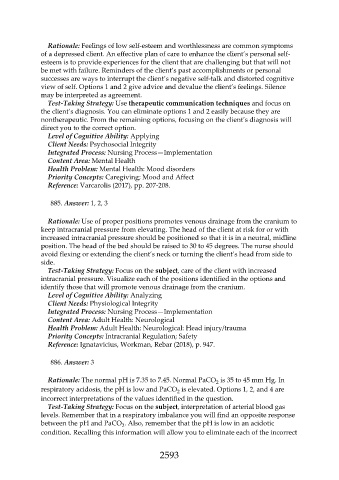Page 2593 - Saunders Comprehensive Review For NCLEX-RN
P. 2593
Rationale: Feelings of low self-esteem and worthlessness are common symptoms
of a depressed client. An effective plan of care to enhance the client’s personal self-
esteem is to provide experiences for the client that are challenging but that will not
be met with failure. Reminders of the client’s past accomplishments or personal
successes are ways to interrupt the client’s negative self-talk and distorted cognitive
view of self. Options 1 and 2 give advice and devalue the client’s feelings. Silence
may be interpreted as agreement.
Test-Taking Strategy: Use therapeutic communication techniques and focus on
the client’s diagnosis. You can eliminate options 1 and 2 easily because they are
nontherapeutic. From the remaining options, focusing on the client’s diagnosis will
direct you to the correct option.
Level of Cognitive Ability: Applying
Client Needs: Psychosocial Integrity
Integrated Process: Nursing Process—Implementation
Content Area: Mental Health
Health Problem: Mental Health: Mood disorders
Priority Concepts: Caregiving; Mood and Affect
Reference: Varcarolis (2017), pp. 207-208.
885. Answer: 1, 2, 3
Rationale: Use of proper positions promotes venous drainage from the cranium to
keep intracranial pressure from elevating. The head of the client at risk for or with
increased intracranial pressure should be positioned so that it is in a neutral, midline
position. The head of the bed should be raised to 30 to 45 degrees. The nurse should
avoid flexing or extending the client’s neck or turning the client’s head from side to
side.
Test-Taking Strategy: Focus on the subject, care of the client with increased
intracranial pressure. Visualize each of the positions identified in the options and
identify those that will promote venous drainage from the cranium.
Level of Cognitive Ability: Analyzing
Client Needs: Physiological Integrity
Integrated Process: Nursing Process—Implementation
Content Area: Adult Health: Neurological
Health Problem: Adult Health: Neurological: Head injury/trauma
Priority Concepts: Intracranial Regulation; Safety
Reference: Ignatavicius, Workman, Rebar (2018), p. 947.
886. Answer: 3
Rationale: The normal pH is 7.35 to 7.45. Normal PaCO is 35 to 45 mm Hg. In
2
respiratory acidosis, the pH is low and PaCO is elevated. Options 1, 2, and 4 are
2
incorrect interpretations of the values identified in the question.
Test-Taking Strategy: Focus on the subject, interpretation of arterial blood gas
levels. Remember that in a respiratory imbalance you will find an opposite response
between the pH and PaCO . Also, remember that the pH is low in an acidotic
2
condition. Recalling this information will allow you to eliminate each of the incorrect
2593

